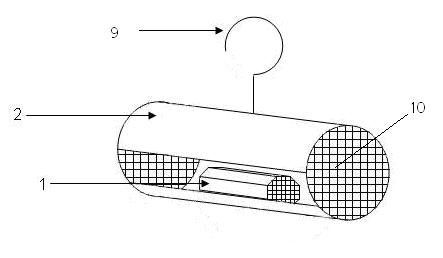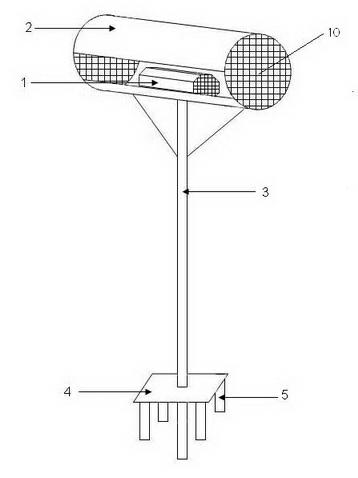Method for continuously releasing parasitic natural enemy insects
A natural enemy insect and parasitic technology, which is applied in the field of biological agricultural and forestry pest control, can solve the problem of high cost, save biological control costs, prolong the control time, and enhance the control effect.
- Summary
- Abstract
- Description
- Claims
- Application Information
AI Technical Summary
Problems solved by technology
Method used
Image
Examples
Embodiment 1
[0019] according to figure 1 , figure 2 As shown, in the release device of the present invention, the release cylinder 1 is a transparent shell structure, and its cross section is a regular octagon. The two ends of the release cylinder 1 are respectively a detachable solid cover 6 and a net cover 8. The middle part of the tube 1 is provided with a mesh partition 7; the mesh diameter of the mesh partition 7 and the mesh cover 8 is between the diameter of the natural enemy and the intermediate host body, the natural enemy can pass through after eclosion, and the unparasitized intermediate host is isolated after eclosion.
[0020] according to figure 2 As shown, a protective cover 2 can also be provided outside the release cylinder 1, the protective cover 2 is provided with a hanging hook 9, the release cylinder 1 is placed in the protective cover 2, and the protective cover 2 is a hollow cylinder of light-colored opaque material, which can It is rain-proof and sun-proof, and...
Embodiment 2
[0023] Using Tenebrio molitor pupae as an intermediate host to release Bacteria zhouii
[0024] A number of release points are arranged in the prevention and control area. The release point is selected at a place with high relative humidity. A set of release device prepared in Example 1 is installed at each point, which can be hung or placed on the ground. When installing, ensure that the release tube 1 is not exposed to direct sunlight. . Determine the number of natural enemies to be released according to the needs of prevention and control. Place the Tenebrio molitor pupae that has parasitic Chow's gnats on one side of the solid cover 6 in the release barrel 1. Before eclosion, place an equal amount of fresh non-parasitic Tenebrio molitor pupae on one side of the net cover 8. After the natural enemy emerges, it will pass through the net compartment 7 successively from the solid cover 6 side, pass through and parasitize the new Tenebrio molitor pupae, and then fly and diffuse...
Embodiment 3
[0031] Using tussah silkworm chrysalis as an intermediate host to release the wasps
[0032] A number of release points are arranged in the prevention and control area. The release point is selected at a place with high relative humidity. A set of release device prepared in Example 1 is installed at each point, which can be hung or placed on the ground. When installing, ensure that the release tube 1 is not exposed to direct sunlight. . Determine the number of natural enemies to be released according to the needs of prevention and control. Place the tussah silkworm chrysalis that has parasitized the wasp Choui on one side of the solid cover 6 in the release bucket 1. Afterwards, it will pass through the net 7 one after another from the solid cover 6 side, pass through and parasitize the new tussah chrysalis, and then fly and diffuse through the net cover 8 and enter the forest area. After the first release, the net cover 8 and the solid cover 6 are reversed, and the host resi...
PUM
 Login to View More
Login to View More Abstract
Description
Claims
Application Information
 Login to View More
Login to View More - Generate Ideas
- Intellectual Property
- Life Sciences
- Materials
- Tech Scout
- Unparalleled Data Quality
- Higher Quality Content
- 60% Fewer Hallucinations
Browse by: Latest US Patents, China's latest patents, Technical Efficacy Thesaurus, Application Domain, Technology Topic, Popular Technical Reports.
© 2025 PatSnap. All rights reserved.Legal|Privacy policy|Modern Slavery Act Transparency Statement|Sitemap|About US| Contact US: help@patsnap.com



